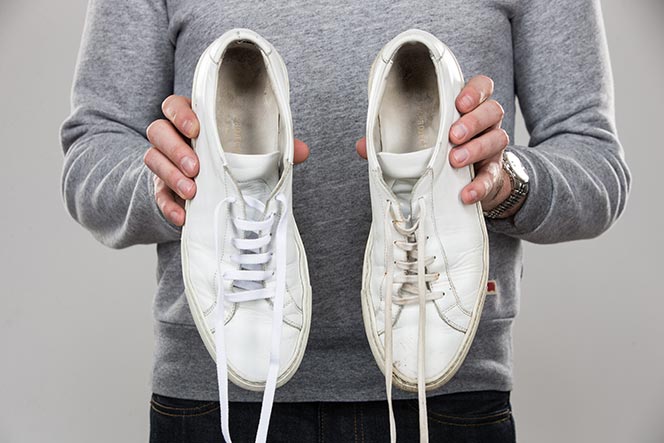
Chefs and other hospitality staff live on their feet. That means their shoes suffer too. Find out how to stand up to dirty shoes with our helpful steps to keeping your footwear sparkling!
Following the release of a range of Shoes for Crews and Mozo non-slip footwear from Tibard and the huge popularity of our ‘How to keep your chef whites white’ guide we thought it was apt to issue another guide for people to use to look after their new shoes. Chef shoes have to be resilient and durable in order to survive the ordeals of the kitchen. Hot, under pressure and constantly being put to work, and that’s just the chefs so you can imagine what the shoes have to deal with! We are hoping with this simple guide we’ll show you how to look after them so they can look after you:
1. Buy the right shoe – let’s get the obvious out the way! If you buy cheap shoes without the required grip; you have a problem. They don’t support your feet, they leave you in pain, they’re not water resistant and don’t offer a huge amount in terms of protection or safety. If you went to a podiatrist as a chef, waiter or bartender complaining about sore feet and you were wearing cheap fabric flats what do you think they would say? There is no point looking after rubbish, so don’t buy it!
If you have got the right shoes and your feet still hurt check out our separate gel insoles and our anti-fatigue floor mats. Or see a doctor!
2. Have a wet cloth available – chefs and other hospitality staff often have cloths very accessible. If you do spill something on your shoes, don’t wait! If you wipe it off with a damp or wet cloth when it’s a spill NOT a stain, your chances of keeping the shoe clean and structurally sound are massively increased. It saves you washing it at home which takes much longer and the damage may already have been done. Kitchens are famously hectic but a few seconds doing an instant wipe can save you hours and money in the future.
3. Be wary of the washing machine – disclaimer, washing machines are great and should be used infrequently to give your shoes a ‘good as new’ look, assuming they’re machine washable of course. However, due to the time pressures of modern life it can be all too easy to just throw your shoes in regularly without thinking long term. High temperature or too regular washes can remove the finish of a shoe and ultimately damage their look far more than a few stains or debris. Sometimes a bit of elbow grease is the best and cheapest medicine for a dirty shoe. Instead of bringing your phone to the loo, why not bring a shoe!
4. A shoe needs to be dry – shoes get wet. If you wash them or if you are caught in a signature British downpour they get very wet. This poses a bigger issue than you might expect. Firstly, athlete’s foot and various other foot orientated problems are more likely when your shoes and by extension your feet are drenched. But for the purposes of caring for your chef shoe not drying it out properly can damage their interior and weaken the support structure. When cleaning or washing your shoes take a few extra minutes to dry them or leave them on the radiator. Avoid direct sunlight and make sure the area you’re drying in is well ventilated.
5. Be flexible – let’s be honest, generally speaking keeping your shoes clean is something you HAVE to do, not what you WANT to do. People have a single strategy for shoe maintenance and apply it across the board. This is a mistake! Understand what you have. For example, on Tibard we have leather, canvas and clog style shoes in our catalogue. To ensure each remains sparkling you have to clean them differently:
Leather – use a brush or cloth to remove dirt or debris. Then apply polish using a wipe, we recommend removing the laces first but that is for you perfectionists. Once the polish has dried buff using a brush to give them a shine. Adding a shoe protector to help keep your leather chef shoes water resistant and easy trick to keep everything straight forward.
Canvas - use a brush or cloth to remove dirt or debris. Then fill a bucket or similar with cold water and some mild washing up liquid. Dip a small brush or tooth brush into the water and gently clean the canvas upper. For best results try a small, soft circular motion. Then use a clean cloth with cold water to remove the soap from the shoe. Make sure the inside is dry and then leave in a well ventilated room to leave the outer material to dry also.
Croslite (Crocs), Plastic or Rubber – rinse with cold tap water to remove any dirt or debris. Wipe with a cloth. If some stains or dirt remain place shoes in a bucket or similar with a few drops of washing up liquid. Scrub the stain or dirt whilst soaking. Rinse again to remove any soap suds and let them dry thoroughly.
We are confident that following these simple steps will enable you to clean your shoes with minimal fuss and time. However, some stains or debris can leave permanent damage or require a professional clean so sadly this isn’t a perfect guide for every situation. Nonetheless, being proactive with your shoe care can save you time and money in the long term and is something we at Tibard recommend for all of our customers.